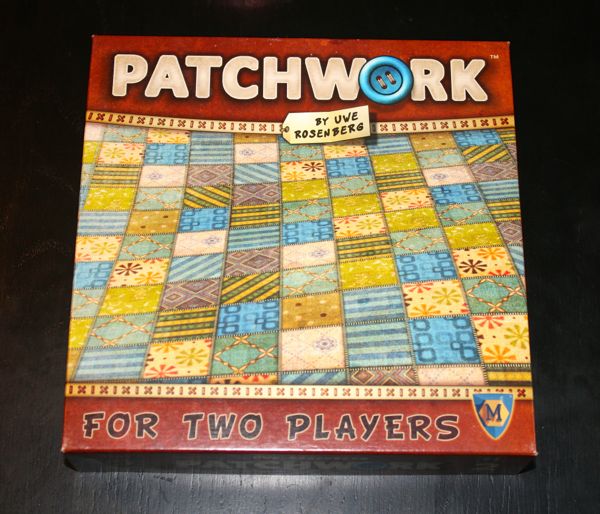
The theme is quilting. The box cover shows a portion of a quilt. As with many designer games, that’s about all that matters.
The actual game has more to do with Tetris than with quilts.
How Do You Play Patchwork?
Patchwork is a 2-player-only game. The box boldly, by nicely, tells you that right on the front.
Each player gets a 9×9 board on which to place the Tetris-like tiles. The tiles are initially spread around the center board forming a vaguely circular path.
The picture below shows that setup a few turns into a game.

There is a wooden pawn (right side of the display above) that tracks where you can take tiles from. On your turn you can take the first, second, or third tile that is clockwise in front of that pawn.
You must be able to afford the cost printed on the tile. The blue buttons are the money in this game. If you can afford more than one, the choice is yours. Take the tile, move the pawn into the vacant space, and place the tile on your board wherever you like.
There is also a time cost on each tile. You must move your marker on the center board the number of spaces shown by the hourglass on the tile you took.
Your goal is to fill your board with tiles (which may not overlap) before your marker reaches the end of the track on the center board. (The reverse of the center board shows a circular track that has the same number of spaces as the squared off one shown above.)
If your marker is the first to pass over one of the 5 single-squares on the center board, you get to take that tile and place it on your board.
If you are the first to cover a 7×7 area of your board, you get the 7-point bonus tile. Note that there are 9 ways to cover that amount of space.

This is not a tile you place on your board. It’s just used for end game scoring.
When both players have reached the end of the center track, you calculate your final score. You add the number of buttons you have left (plus the 7-point bonus, if you got it) and subtract to points for each square not covered on your board. Most points wins.
Can You Strategize in Patchwork?
There are several areas in which you can think ahead when playing Patchwork.
The most obvious involves the placement of the tiles on your board. If you have good spatial relations abilities, this will be easier for you than for those who don’t know up from down.
You can look ahead on the tile path to see what will be available to you on your next turn. Most of the time this is pretty easy to figure, since only one other person can have a turn before you get yours again. However, it is possible for a person to take more than one turn in a row.Whichever marker is farthest behind on the track takes a turn.
Whichever marker is farthest behind on the track takes a turn. If the time payment on the first tile you take leaves you behind (or on top of) the other player’s marker, you get another turn.
Checking how much money (i.e., how many buttons) the other player has can be helpful too. If you can see that your opponent won’t be able to afford any of the next three tiles on the path, you might be able to use that to your advantage.
If you can’t take a new tile, you simply move your marker along the center track until it passes the other player’s marker and take buttons from the supply equal to the number of squares you moved.
Notice that along that center track there is a button every so often. When you pass that icon, you collect the number of buttons shown on the tiles already on your board.

Put all this together and you get a really fun strategy board game for two. It plays so quickly that you’ll probably play it more than once at a sitting. Best of 3, anyone?
Get your copy of Patchwork at Amazon.
